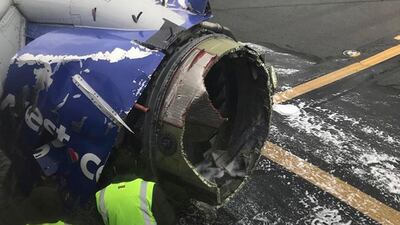A bank executive died after being sucked half-out of a US passenger jet flying at 32,000 feet when shrapnel from a blown engine smashed a cabin window.
Fellow passengers grabbed Jennifer Riordan, 43, and dragged her back into the plane, then tried to plug the hole after the sudden loss of cabin pressure.
The pilot took the Dallas-bound twin-engined Boeing 737 with 149 people aboard into a steep descent as passengers using oxygen masks that dropped from the ceiling said their prayers and braced for impact. The plane, flying from New York, landed safely in Philadelphia.
“I just remember holding my husband's hand, and we just prayed and prayed and prayed,” said passenger Amanda Bourman. “And the thoughts that were going through my head of course were about my daughters, just wanting to see them again and give them a big hug so they wouldn’t grow up without parents.”
Ms Riordan, a Wells Fargo bank executive and mother of two from New Mexico, died despite attempts to revive her on the flight. Seven others suffered minor injuries.
A preliminary examination of the blown jet engine showed evidence of "metal fatigue," said US transport officials. As a precaution, Southwest said that it would inspect similar engines in its fleet over the next 30 days.
_____________
Read more:
World's least safe airlines 2018 revealed
World's safest airlines 2018 revealed
_____________
In a recording of conversations between the cockpit and air traffic controllers, an unidentified crew member reported that there was a hole in the plane and “someone went out”.
Passenger Alfred Tumlinson said a man in a cowboy hat rushed forward a few rows to grab the woman and pull her back in. “She was out of the plane. He couldn't do it by himself, so another gentleman came over and helped to get her back in the plane, and they got her,” he said.
Mrs Bourman said she was seated near the back and was asleep when she heard a loud noise and oxygen masks dropped. She said the plane was fairly quiet because everyone was wearing a mask.
“Everybody was crying and upset,” she said. “You had a few passengers that were very strong, and they kept yelling to people, you know: ‘It’s OK. We’re going to do this.’”
Passenger Marty Martinez went on Facebook Live while wearing an oxygen mask. He posted: “Something is wrong with our plane! It appears we are going down! Emergency landing!! Southwest flight from NYC to Dallas!!” After the plane landed, he posted photos of a broken window near the left engine.
Everyone started yelling to brace for impact as the plane came in for a landing, Mrs Bourman said. She said passengers clapped and praised the pilot after the aircraft touched down.
Tracking data from FlightAware.com showed Flight 1380 was heading west over Pennsylvania at about 32,200 feet (9.8 kilometres) and travelling at 500mph (804.7kph) when it abruptly turned toward Philadelphia.
The last time a passenger died in an accident on a United States airliner was 2009, when 49 people on board and one on the ground were killed in the crash of a Continental Express plane near Buffalo, New York.
Southwest has about 700 planes, all of them 737s, including more than 500 737-700s like the one in Tuesday’s accident. It is the world’s largest operator of the 737. The 737 is the best-selling jetliner in the world and has a good safety record.
The jet’s CFM56-7B engines were made by CFM International, jointly owned by General Electric and Safran Aircraft Engines of France.
CFM said it sent technical experts to help investigators from The National Transportation Safety Board (NTSB).
In a statement, it said the CFM56-7B has had “an outstanding safety and reliability record” since its debut in 1997, powering more than 6,700 aircraft worldwide.
John Goglia, a former NTSB member, said investigators will take the engine apart and look at its maintenance records as well.
“There’s a ring around the engine that’s meant to contain the engine pieces when this happens,” Mr Goglia said. “In this case it didn’t. That’s going to be a big focal point for the NTSB – why didn’t [the ring] do its job?”
Mr Goglia said the Boeing 737 is a safe plane, but that engine failures happen from time to time.
“We’re pushing the engines to produce as much power as possible,” he said. “We’re right on the edge. Sometimes they fail, and that’s why the containment ring is there.”
The engine failure was reminiscent of a similar event on a Southwest Boeing 737-700 jet in August 2016 as it flew from New Orleans to Orlando, Florida. Shrapnel from the engine left a five-by-16-inch (12.7-by-40.6-centimetre) hole just above the wing, and the oxygen masks dropped. The plane landed safely in Pensacola, Florida.
NTSB investigators said one of the engine’s fan blades broke off during the flight, apparently because of metal fatigue.

